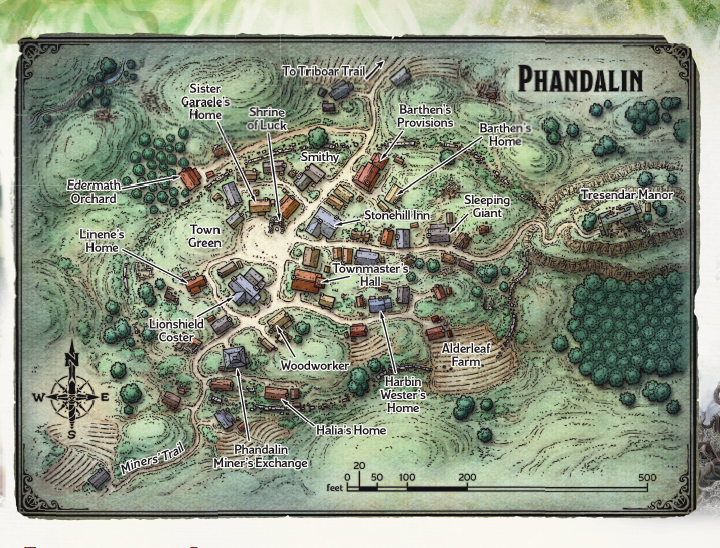
This time, armed with info about the caverns from their first foray in, the party successfully used Stealth to get the jump on the Cragmaw Hideout guards, sneak into the caves, and get all the way to the Bugbear chieftain’s chamber without the alarm going up.
Now, instead of the Bugbear chief simply fighting to the death, he offered the party a deal (partly because the warlock successfully used dissonant whispers on him): He’ll let them have his hostage (Sildar Hallwinter) without a fight if they promise to walk. The party took him up on his deal, took Sildar out of the caves, and left the Cragmaws for the town of Phandelver. Part of my job to make the world feel real is to give my party’s opponents goals, drives, and personalities beyond a stat block, and once Klarg was surrounded, this felt like something he would do to try to save his life, his gang, and his home base.
Phandalin
This session was critical to the entire campaign because this is when the party first arrives at the town of Phandalin. It is IMPERATIVE to the story that the characters bond with this town and its residents. I added a couple of personal elements to the story to help this along:
- Twilly the druid has a home here - gifted to her by her aunt. Her ex-girlfriend (and new fiance!) lives here.
- Edermath is an old colleague of William Hawksley’s father and has been asked to help William establish Hawksley business here.
The adventure as written does a great job of presenting Phandalin as a sandbox. As the party visits different locations multiple next adventures are presented by different NPCs and I made a point to ensure many were offered in this first trip to town. The players loved the feeling that the adventure was not on rails, and that they had a LOT of options as to what to do next.
Of course, the FIRST thing they did was deal with some Redbrand bullies. The day a group of players ignores an opportunity to put a group of cruel bullies in their place will be the day I give up gaming. 🙂
DM Tools:
This chapter is where the Phandelver DM Screen really worked for me. It has a table that lists all the important Phandalin NPCs, their rumors, etc. I always struggle with names of lots of NPCs in a single place. Also, the art of Harbin Wester… [chef’s kiss] - kudos to Wizards - great add to roleplaying that NPC.
MINMAXING:
The drow sorcerer was built to be effective/tough in close combat. Here are a few steps Robert C took to do that:
- First, he chose drow, which gives him drow weapon training (rapier)
- Chose draconic bloodline as his sorcerous origin - giving him additional hit points and a higher natural AC
- Maxed out dexterity (for rapier)
- Chose spells like green flame blade, booming blade, shield, and faerie fire
Carefully combining these options gives him a sorcerer that can wade into battle and hold his own!
RP:
I feel like talking about humor at the table today. Every game, every table, every DM will use varying degrees of humor in their game. The amount of humor I integrate into a game of Faster, Purple Worm! Kill! Kill! is profoundly different from the humor found in my long-running standard game. There is no wrong answer on how to integrate humor into your game, but I’m going to focus on my own preferences for a (non-streamed) long-running, epic campaign.
My favorite form of humor during a D&D game is ‘in game.’ Meaning, we laugh as a result of something a character does or says within the circumstances of the in-world action. For example, JahZin, the warlock from a far away land, makes a funny comment about something in the Sword Coast culture he just doesn’t understand. Hawksley, after a failed move in battle, screams about how he’s letting his father down. I love these kinds of laughs.
My least favorite form of humor are comments that are out-of-world and tend to erode at the stakes of the story. Nothing takes the wind out of my sails like a player making an out-of-world joke to lampoon a particularly high-stakes in-game moment. The key here is out-of-world.
GOOD: A huge demon appears and threatens the party. Character A quips, “I shoulda taken those religion classes more seriously as a kid.”
NOT GOOD: A huge demon appears and threatens the party. Player A quips, “That thing looks like the stay puff marshmallow man. Jon, I throw a bag of marshmallows at it.”
As I said above, every table is different. My personal preference is to mix high-stakes drama, verisimilitude, and character and circumstance-driven humor.
Next: Session 4


0 comments